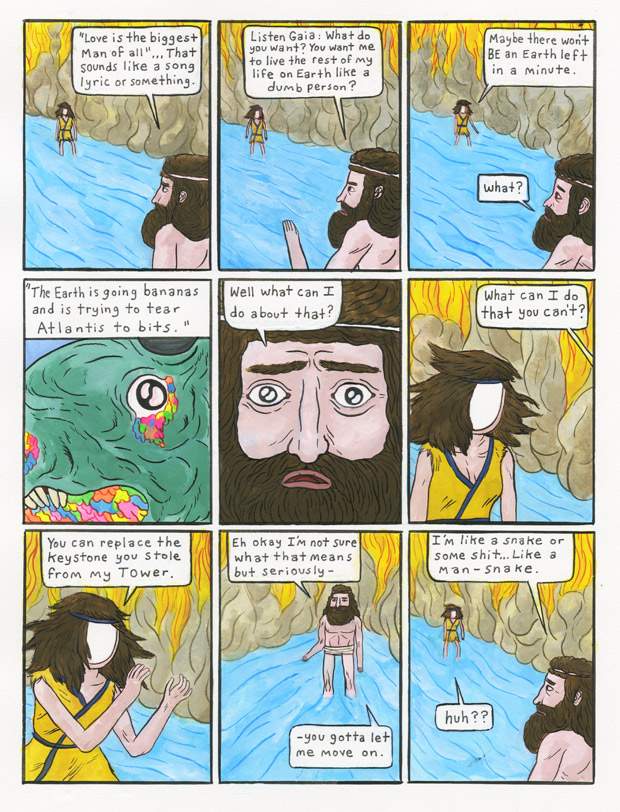Taylor Swift
Shared posts
Visualizing MBTA Data
Taylor SwiftMake sure you check out the interactive part at the bottom, this is amazing
Conrad Schnitzler & Doc Wör Mirrran - Amarillo
Taylor Swift!!!!
MP3 / FLAC
Label : Nostalgie De La Boue [ndlb#46], Ivory Coast, 2014
Conrad Schnitzler, a legend of german avant-garde electronic music, passed away on August 4th 2011 in Berlin. Short before that, he made a few recordings with Doc Wör Mirran, resulting in those two excellent tracks that I'm honored to share.
Tracklist :
1. Amarillo (9:45)
2. Brillo (12:06)
The Trashwomen - Spend the Night With The Trashwomen (1996)
Taylor SwiftROCK FACTS: That's Kreayshawn's mom on the lower-left!
Goodiepal and Xiotron split cassette distributed via Norwegian mountaintop

"What I'm aiming for is to make a musical artefact that will unite the hiking experience, the scenery and the music," says Norwegian musician Trond Jervell. In line with this ambition, Jervell is is distributing his next release (a split cassette with an artist used to doing things the unusual way – Goodiepal) via Norwegian mountaintop.
Jervell contacted Goodiepal last year and asked if he would like to participate. "He was very positive," says Jervell, "and sent me a musical piece called "Acid Op I Det Fjæl Der!", which roughly translates to: "Acid Up In That Mountain There!"
Jervell arrived on the idea while walking in the mountains of Lofoten last autumn. "I was thinking of a way to unite the physical feeling of the walk, the emotional experience of the sights/view with a musical counterpart," he says. The solution was simple: make music inspired by the walks and give them away for free via the mountaintop mailboxes. He chose tapes because they fit in the boxes, and that they are harder to rip MP3s from, anchoring the release more firmly to the mountaintop.
Jervell will be tweeting the name of the mountain when he drops them off, leaving a walkman with the cassettes so they can be listened to in situ. "If everything goes according to plan, there will be a Walkman on at least two mountaintops around the archipelago of Lotofen," he says. "Hopefully someone will take the time to listen to the pieces in their right, natural enviroment."
Goodiepal's piece fills side A, and the B side includes a piece by Jervell as Xiotron, plus a description of how to reach the top of the Ristinden mountain, narrated by a local called Esben.
100 copies of the tape have been printed, and the first five were dropped in a mailbox on Offersøykammen on the western edge of Vestvågøya on 6 June. For more scenery, or details of where to get yours if you happen to be in the vicinity of one of the Norwegian mountains in question, follow @_L2XK on Twitter.
Planet Speaks: Firaxis devs talk Civilization: Beyond Earth
Taylor SwiftThe INCREDIBLY DRAMATIC classical music which ALWAYS PEAKS as the soft-spoken guy starts to speak is fucking killing me
Although E3 has more to do with console grandstanding than anything PC-related, occasionally bits of info filter through the noise, unladen by the forced enthusiasm and hyper-masculine pheromones that still permeate the market. Today GameTrailers posted an interview with Civilization: Beyond Earth designers David McDonough and Will Miller, and it’s more revealing than the brief teaser trailer we saw back in April.
In particular, there’s actual gameplay footage sprinkled through the interview like so much panspermic dust. Beyond Earth looks and behaves a lot like Civ 5, which is to be expected seeing as it runs on the same engine. I’m not too sold on the blurry, dim aesthetic. Despite the proliferation of neon colors nothing really pops out. The terrain types are indistinct, the ocean color seems off, and the overall palette resembles a King cake chewed up and spat out. It’s the worst I can remember a Civ game looking since Call to Power.
Gameplay-wise though, there’s reason to be excited. The tech web, affinities, and quest system are promising, and the SMAC-esque narrative elements seem convincing–especially in the eloquent descriptions of McDonough and Miller. See what I mean:
The Harmony player, in an homage to Alpha Centauri, will actually discover that the planet itself is sentient, and build these giant biomechanical machines to communicate with it and transcend the way we think about the planet, and how we interact with it. [...] So your investment in [your choice of affinity] over the course of the game is going to color everything about your civilization, from the way your leaders look, to the way your military looks, how it progresses, how it upgrades, the unique units that you’re able to build, and how you take advantage of the world around you.
It sounds like your choice of faction will have a pronounced influence on how the game plays out, in a way that goes beyond a mere unique unit or situational bonus. That’s sure to please the all-important “SMAC fan” voting bloc, who’ve been growing restive ever since ’99. The full interview appears below.
Whac-a-Bison (Vega)
Taylor SwiftSincerely incredible.
The last time I covered a previously unemulated title in the official Street Fighter series is when I was announcing that CPS3 had been emulated for the first time and you were seeing the first screenshots from my work on Street Fighter 3.
That event generated a lot of publicity for the project, some good, some bad, but one thing it did do is make people realise that MAME was still around and that we were still working hard on improving the project; it got people interested and allowed them to see what else we’d been working on in the years since they’d last taken a look.
This update concerns a different member of the Street Fighter series, one of the harder to come by titles and I’m hoping it helps demonstrate how MAME is branching out.
The game in question is “Ken Sei Mogura: Street Fighter II” and it’s kinda special. Street Fighter II is arguably one of the most influential arcade titles of all time, after seeing the success of the game almost every other arcade developer immediately felt they had to come up with their own vs. fighting game to compete with it.
Ken Sei Mogura is another product that came into existence due to the iconic status Street Fighter II had quickly attained but until recently it had remained undumped and unemulated.
For those not familiar with the game it’s an official Capcom product developed in conjunction with Sigma and the relatively unknown Togo. The video and audio for the game are provided by Capcom’s popular CPS1 platform, the very same board that powered Street Fighter II itself. The game uses the original Street Fighter II assets and a modified version of the game engine so it’s fair to say it’s one of the closest relatives to the original game.
The twist here is that this is not an actual fighting game, it’s a Whac-a-mole title, one of those games where little heads pop up and you have to use a hammer to hit them back into the ground. The whole machine is Street Fighter II themed, the moles are Bison (Vega) characters and the on-screen characters play out a fight based on your performance.
There are a few videos of the game on YouTube, at least two of them from the same arcade in Japan, but it’s not exactly a common game these days.
What makes the rest of this story more surprising is how I came to be writing this article in the first place. Of all places for one of these machines to show up the UK wouldn’t exactly be your first guess but that is exactly where a machine was found, in a disused location and already subjected to various levels of vandalism.
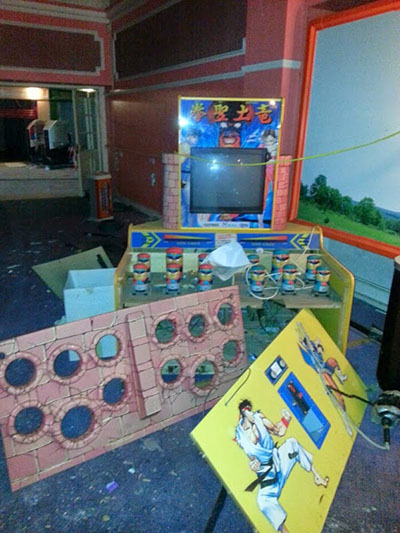
The man to secure the unit (or at least for the time being the PCBs) effectively saving them was Alan Meades who kindly got in touch with us about the possibility of emulating the boards.
He provided a number of pictures of what he had uncovered, confirming what we’d already been told; that the game ran off a Capcom CPS1 board, but also shedding some light on the additional hardware the machine uses. Manuals and connection diagrams (mostly in Japanese) were also found, interestingly there was an English translation of some bits of the manual which is curious because the game to my knowledge was never released outside of Japan yet the translation refers to Vega by his non-Japanese name of Bison.

The most significant thing that was discovered was the ‘Drive Board’. This Drive Board was one of several additional PCBs used by the game, and importantly on it was a CPU and a ROM. This, combined with some information in the manual shed some light on the unique hardware setup that had been chosen for this game.
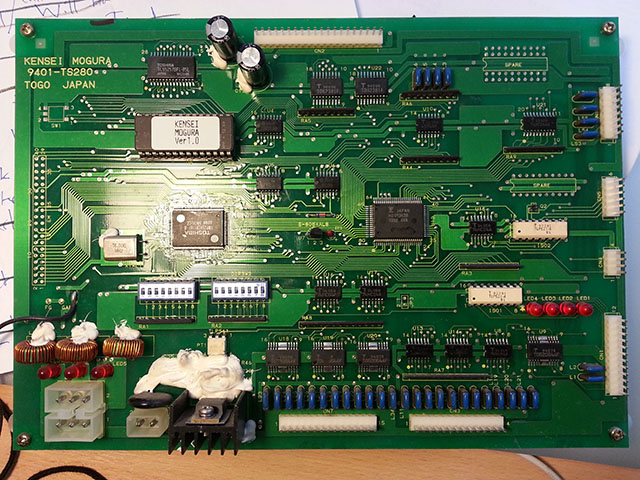
The CPS1 board as it turned out was simply a slave board, it only works in response to commands sent by the Drive Board; all inputs etc. were connected to the Drive Board instead of connecting directly to the Jamma connector on the CPS1 board. This actually isn’t too surprising, the base CPS1 board is quite limited in terms of I/O capability with Capcom already having had to squeeze the kick harness connectors on the C boards so driving the game from a more suitable board with significantly more I/O ports makes a lot of sense when you’re dealing with the kind of mechanical hardware used by this game.
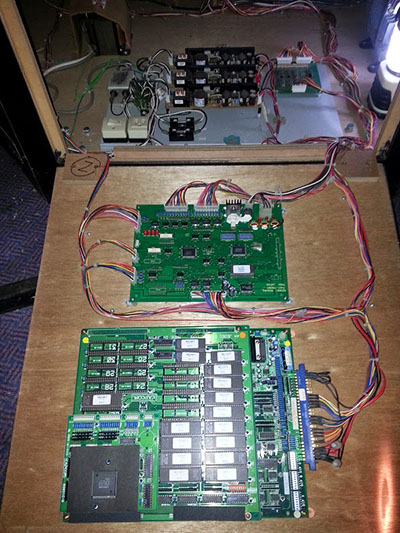
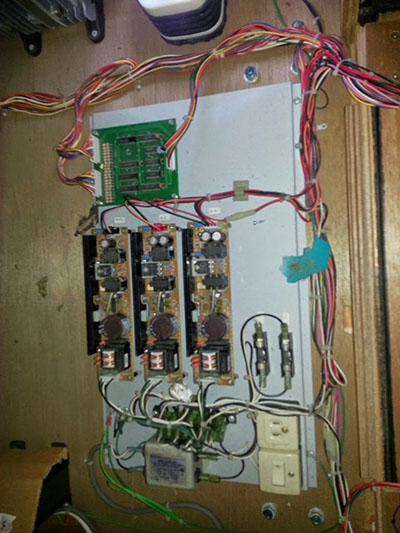
Anyway, it didn’t take long for both these boards (the CPS board and the Drive board) to be shipped off to Porchy who quickly dumped the ROMs on them, including the PAL (different CPS games use different PALs to control the graphic addressing and this one was unique to this game)
I quickly hooked up the CPS1 side ROMs in MAME and unsurprisingly they didn’t do a great deal beyond displaying a cryptic ‘LV’ error message. Porchy confirmed that the real CPS1 board does exactly the same when no additional boards are connected, so while it was initially anti-climatic it was also good news.
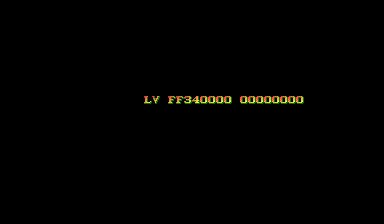
Before proceeding with the emulation a couple of things in MAME needed tidying up. The main CPU on the drive board was a TMZ84C011, or in clearer terms a Z80 clone with some extra I/O ports and the Z80CTC built in.
MAME already had emulation of the TMZ84C011 for a number of Nichibutsu Mahjong drivers where it had been used as both a main CPU and a sound CPU on a number of Mahjong game PCBs. The implementation in MAME however had simply been copy and pasted between drivers with the port handling hardcoded for each game. This is mainly because said drivers predate the modern MAME method of creating shared devices and setting up port callbacks for such hardware, and also predate the ability to define custom CPU types with built in peripherals. None of these limits exist anymore so I took a day or two to modernize that code and set things up properly, cleaning up the code and reducing the amount of duplication in MAME in the process.
The other chip of note on the Drive PCB was a MB89363B. To work out what that was we asked Stiletto to dig out whatever information he could find on it. In the end it turned out to be a chip more commonly used in radios and simply amounts to 2 i8255 I/O chips glued together in terms of functionality. Again no great surprise the board was clearly built for heavy I/O use.
Santeri Saarimaa (Gridle from the old mame.net) also lent a hand at around this point, translating a few bits from the Japanese manual into English. It’s very uncommon to have a manual to work with when doing emulation work, but for a set-up like this it was a time saver; one of the pages lists (in Japanese) what each of the pins on each of the Drive PCB connectors is hooked up to and in this case that information came in handy because of the unusual way the Jamma connector is being abused as a communication port. By cross-referencing the diagrams in the manual with the standard Jamma Pinout I was able to confirm my initial feeling that the communication ports had been hooked up where the 4 joystick directions usually connect for each player (to form one 8-bit port) as well as where the two Player Start buttons and Service Coin usually map (for additional flags) That gave 11 lines for the Drive board to send messages to the CPS1 board. For communications the other way the usual Coin Lock and Coin Counter outputs were abused in a similar way to give 4 lines for communicating responses back to the Drive board.
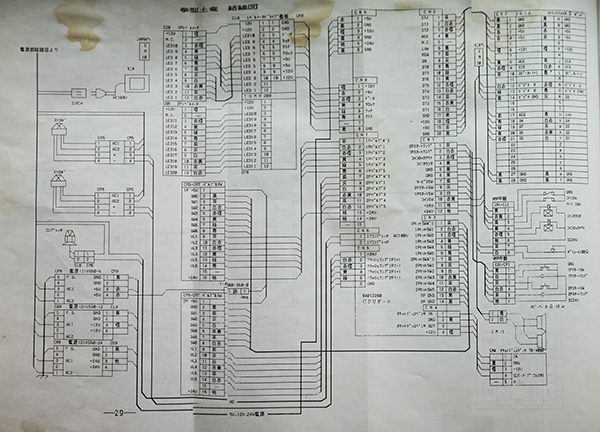
I did a fair bit of tracing of the game code for the Drive board CPU at this point in order to try and establish where those ports mapped on that side of the setup and was able to quickly rule out a number of ports that were clearly dipswitch related, as well as those used for the coins, start lamps and start buttons thanks to the translation work Gridle had done.
One other set of accesses stuck out more than others, those turned out to be a serial port for communicating with the ‘Level’ LEDs on the control panel, due to the serial nature of the port (1 bit of data at a time) and frequency at which the LEDs are meant to change those ports were extremely ‘noisy’ in the logs compared to others. I hooked these up and the results were pleasing, the display made by the LEDs (lighting up from one end to the other) matched the power-on description in the manual.
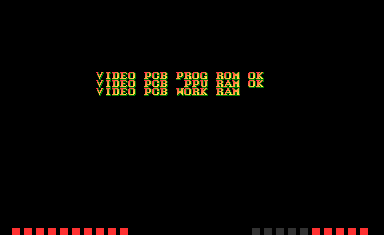
Other ports were performing 0x3f (6-bit) masks on read and write operations, and often used in pairs. Knowing that there were 6 moles per player I quickly concluded that those ports must be the ones used to drive the moles and read the status of the hits.
In the end I was left with exactly the right number of ports / bits needed for the communication ports, however no matter what I tried they didn’t seem to want to map correctly. I knew these were the communication ports because if I returned completely random values the game did start to do random things, allowing me to produce screenshots like the one below.
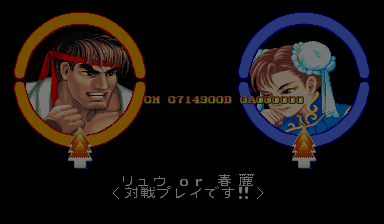
In the end ‘hap’ provided some assistance here, it turned out I’d got everything hooked up to the right places but my logic was inverted (or more correctly, the communication logic on the PCB was inverted) so the commands that were being sent between the CPUs in MAME weren’t what was expected at the other end.
With that fixed the game attract mode started to run and the notes I’d made earlier about what each of the other ports should be were proven to be correct. I hooked up the start lamps and made a video of the current progress. The game was quite interesting to see in action at this point because none of the mole inputs or outputs had been mapped, this resulted in the game thinking all the moles were constantly ‘hit’ so if you coined up you would always win with the maximum number of points! (it also showed that Player 1 hits always take priority over Player 2 hits if you hit at exactly the same time, so in a 2 player match Player 1 would always win!)
I then spent a bit of time cleaning up the dipswitches, and attempted to hook up the moles to some basic clickable ‘internal’ artwork. Knowing exactly which physical mole maps to which bit of the I/O port doesn’t actually appear to be possible without having a working cabinet running the test mode, so I had to make a few guesses; knowing one of the moles for each player was bigger than the others at least meant mapping 1 of the 6 was easy because during testing I noticed that one specific mole would always give 2 points instead of 1 point; obviously that was meant to be the big one.
That brings us to where we are now, a playable game that just a week ago was completely undumped and unemulated. A game that a couple of years ago people might have not even thought to be suitable for emulation in MAME due to the mechanical element of it. The actual game is quite short, you’ll play a round vs. either Chun-Li or Ryu (depending on which character you pick) and if you beat them you’ll face Vega. There are dipswitches to control the difficulty, but the main appeal of the game came from it being a whac-a-mole, so the short length is understandable, it’s not the type of thing you expect to play for an extended period!
With MAME these days we’re always looking for new and different things to emulate, it actually surprises me greatly that there aren’t more mechanical whac-a-mole games in MAME, we could easily emulate non-video ones if they were dumped exactly the same way the non-video mechanical part of this one has been emulated.
Eventually I still hope MAME gets the ability to recreate full 3D cabinets, the layouts you see at the moment are basic 2D ones using the internal layout system, those could of course be improved using scanned artwork etc. as Mr. Do has done for a number of other games.
So if this article grabbed your attention and you’ve managed to read it to the end I hope you’re now more aware of how MAME is always changing, always growing, and how things you might not have even considered emulation candidates very much are these days. We’ve got this kind of thing, Fruit Machines, and if you look at the MESS/UME part of the code we support computers, consoles, cash registers, you name it. If it can be emulated then as a project we’re interested in emulating it. If you found this update interesting then please share it!
Special thanks must go to Alan for securing this incredibly rare piece of history, Porchy for dumping it and hap, Gridle and Stiletto for their roles in helping to get it emulated not to mention the original authors of the CPS1 driver and all the various components I’ve made use of in doing this; if the whole thing needed to be done from scratch it would have been a lot more time consuming!
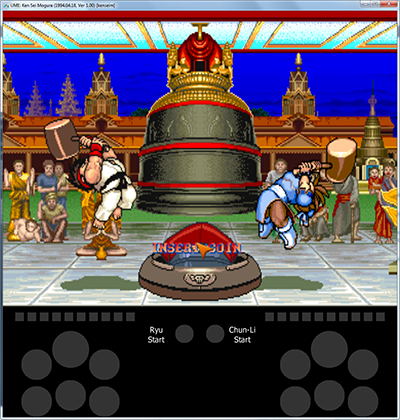



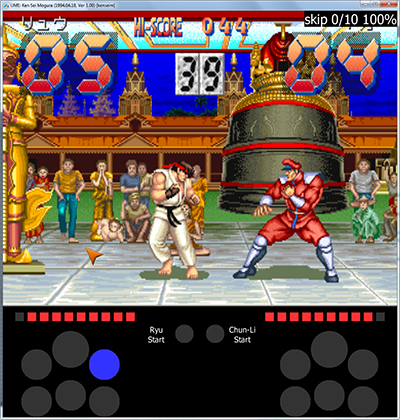

Other News (part 3)
Taylor SwiftWhat the fuck?!?!?!
Bouncing Balls is one of those Korean titles that has always left me scratching my head. First of all it’s one of the few Comad games I can’t attribute to simply being a hack of something else (along with Pushman, which runs on the same hardware – the hardware being a copy of Capcom’s F1 Dream, but with different protection*)
* come to think of it, why is the original F1 Dream even marked as working, you can drive through the walls.
Second, they decided that the best theme for the game would be Warner Bros character designed, in this case Marvin the Martian and Duck Dodgers (Daffy Duck), unlicensed of course. The game is a simple puzzle game, and in the existing MAME set these characters are used for both the foreground sprites and in-game background images.
When I say it’s a simple puzzle game, I mean it’s a simple puzzle game, basic addition and subtraction, putting balls into the appropriate slots to reach a target value, without exceeding it. You’d be forgiven for thinking it was actually a game aimed at kids, but then the whole thing is turned upside down, because between rounds you get undressed / suggestive pictures of women. See these censored screenshots from MAME.


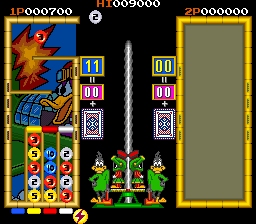

Recently system11 dumped another version of the game, the new set still uses the WB characters for the foreground sprites, but replaces ALL the backgrounds with low quickly monochrome images of women, not just the bits between rounds. This is slightly more in Comad’s style, although it’s still the same rather pointless game! Interestingly this version also has patterned backgrounds rather than being blank.
It appears this set has less images overall because if you look in the test mode / tilemap viewer (the tilemaps are hardcoded as one big layout stored in ROM) then you can see only about 2/3rds of the tilemap has valid images in this new set with the rest being corrupt, as opposed to the older one where it was all used. ALL the roms are different on this set, so it isn’t just some cheap hack, Comad actually thought it was worth putting both of these to market.




Had a version with no adult pictures at all shown up it might have actually made more sense, because I can’t see any adult actually wanting to spend any time with it unless they were completely innumerate; the images aren’t even worth seeing, and the game is Fun School level.
I didn’t actually spend any time adding this myself, Brian Troha took care of the addition because it simply slotted into the existing driver.
Berlin-Gesundbrunnen Train station
Germany being the sort of country it is, it divides its railway stations up into 7 different numbered categories, in order to keep customers transparently informed of what sort of amenities different stations on the network will contain. The highest category is category 1, which covers some 20 train stations in Germany. Usually the main stations of major cities, these category 1s will be large stations that are open and staffed 24 hours, and usually contain a shopping center. Berlin has four category 1 stations. These are: Berlin Hauptbanhof, Berlin Ostanhof, Berlin Südkreuz, and Berlin-Gesundbrunnen.
Gesundbrunnen station sits in the eponymous district in the north of Berlin, a working-class area that was right on the edge of the West during the Cold War period; from the station, it’s about a ten minute walk into Prenzlaur Berg. The station itself was rebuilt extensively following reunification, and its present status is entirely a result of the post-reunification transport plan for the city, which involved the building of the Hauptbanhof where the old Lehrter Bahnhof used to be. Under this plan, Gesundbrunnen became Berlin’s main station for northbound long-distance train services. As such, it is very well-connected to the rest of the city’s transport network, intersecting many S-Bahn lines, including the Ring, as well as the U8.
But Gesundbrunnen is not exactly a building. The platforms – huge and, except for the S-Bahn side, mostly empty – stretch out one after the other below the Swinemünder Brücke without any railway shed. The station even lacks any sort of facade: one simply takes a staircase down from a public square, with the shopping center (which category 1 status is presumably contingent on) adjacent. Visiting Gesundbrunnen, one does not get a sense of being at a place where a journey could ever start or finish. No one seems to be using it to go anywhere grand, or special. Both architecturally and in practise, it can only be imagined as a place where people are transitioning, from the mundane into something equally everyday.
For the most part, the 20th century did for cohesive railway station architecture. In the UK the most famous example of this was probably the demolition of the Euston Arch, but we see it all over the big stations in London and the majority of big provincial railway stations: one departs from one’s transport connection and walks through some shops to some platforms. This is our experience of railway buildings. When I first saw photographs of great 19th-century railway station buildings, I was shocked. These places looked like cathedrals. One really got a sense of a railway station being something, and indeed they were: the great stations were mostly built as the proud termini of independent railway companies, and as such they had a coherent identity that, once maintaining a railway station becomes a merely administrative task for some bureaucracy, ends up seeming unnecessary to the people in charge.
It is still of course possible to see old-style railway stations like this, but for the most part, they are historical accidents. Budapest has two, and the Keleti and Nyugati stations are both really masterpieces, but one gets the impression – as with so many of Budapest’s stunning buildings – that they really only still stand because nobody ever had enough money to knock them down. And London is rightly proud of St Pancras, although of course they did want to knock that down for a long time, and it also happens to stand next to King’s Cross, the sort of building that, from the outside, looks absolutely nothing what it does from within, and therefore serves only to obfuscate. Berlin’s Hauptbanhof, meanwhile, is definitely an attempt to produce a coherent building, a place where things might start and stop, and while not exactly beautiful, it is at least to be applauded.
Without any coherent shape or structure, Gesundbrunnen cannot quite seem to stand as something that enables a journey. Rather, it is an obstacle that must be navigated for one to make a journey. This is experienced no better than if one tries to walk around it. If one tries to do a lot of walking around a big city, one quickly realises that, although walking is certainly allowed, the road layout tends not to encourage it, in a certain sense. This is because walking around a city tends to be perfectly straightforward and enjoyable in between transport hubs, but once you start to approach one, your progress becomes bottlenecked, you start having to navigate a lot of underpasses and traffic islands and things like this, and you frequently become trapped in knots of people who are trying to go in the other direction to you. Approaching Gesundbrunnen is like this. It has the feel of something that has been spilled on the city around it, but which hasn’t been mopped up yet.
The great train stations of the 19th century stood as icons of a capitalism that was associated with increasingly great human achievements, with progress. Later on, capitalism sold itself as the economic system that most effectively enabled the happiness of individuals. Post-Cold War, capitalism became post-ideological, presented as something that was simply inevitable, as if programmed into the very fabric of the universe. Nowadays, capitalism has lost its enabling-character. In particular since the financial crisis, capitalism presents itself as an obstacle for the individual: a hindrance that people are (arbitrarily, based on background and other talents) either better or less well-equipped to navigate. You have no other option but to make your journey via it, but it is something so crappy that to remain totally within it, would be at least as boring as death. As the Euston Arch, or Berlin’s Anhalter Banhof, or Budapest Keleti, stood as symbols of the capitalism of the 19th century, so does Berlin-Gesundbrunnen, as a symbol of the obstacle-capitalism of the early 21st.
Galaxy Print Sailor Uniform & Sailor Moon Accessories in Harajuku
Taylor Swift1000% into the invention of Sailor Boh
Nata and Sato@310 are two Japanese high school students who we met on the street in Harajuku.
Nata – on the left – is wearing a galaxy print Japanese sailor uniform with star socks and flats. Accessories include a Sailor Moon pendant on her tie, a Sailor Moon backpack, colorful bracelets, a large ring, and cute hair clips.
Sato@310 – with the Japanese elementary school hat – is wearing a cardigan sweater over a graphic t-shirt from the Harajuku resale shop Panama Boy, a long red skirt, ruffle socks, and black flats from Bunkaya Zakkaten. Accessories include a heart necklace, a rising sun tote bag, and a needle pin. Sato@310′s favorite shop is Kinji Harajuku and she likes the music of Urbangarde.








Click on any photo to enlarge it.
Grimoire Tokyo Skirt w/ Bunkaya Zakkaten Doll Face Bag & Tokyo Bopper Platforms
Taylor SwiftTHESE BAGS??????
This Harajuku girl with braids and a face mask is Mio. She is wearing a monochrome outfit with lots of eclectic accessories.
Mio told us she borrowed the jacket she’s wearing from her mother, and she paired it with a skirt from Grimoire. Her doll face bag is from the well-known Harajuku shop Bunkaya Zakkaten and her cutout rocking horse shoes are Tokyo Bopper. Most of her accessories are from Bunkaya Zakkaten and an “ethnic shop” – include earrings, beads bracelets, various necklaces, teeth rings and printed tights. She is also wearing a white Bunkaya Zakkaten backpack with a wooden insert.












Click on any photo to enlarge it.
Tomodachi Life 3DS Review: Conversation Piece
Savoring the Realm: Sightseeing in Eorzea
Review: Vangers: One for the Road
Taylor SwiftStill super interested in this game, maybe even moreso now that it has revealed itself as self-obfuscatory and maybe very frustrating

I’m not sure if I have a mouth or not, but in the event that I don’t, I would still like to vocalize my discomfort.
“Sale prices vary between the seasons. One cycle you might get 540 beebs for a gluek, but if you wait you might get 920 beebs for it in the next cycle.”
“As soon as you can, start doing a few tabutasks.”
“Section 5: Avoiding Getting turned into a Raffa on Glorx”
The above are excerpts from GameFaq’s Vangers Guide v1.2b, by “Slicer.” It is a document I referenced several times over the course of my play with Vangers: One for the Road. Originally released in 1998, Vangers is an all-too-literal crossbreed of racing, role-playing, and speculative fiction, with players stepping into the biomorphically ill-defined shoe-appendages of a futuristic, world-hopping highwayman cum delivery driver. Vangers is a game which exists at the crossroad between the mundanity of basic supply and demand economics and the existential horror of unchecked exploration and genetic tampering.
And to reiterate: there is a racing game here, somewhere. I think.
The premise—as imparted to the player through slang-heavy conversations with prominent slug creatures and other twisted aliens—is that war between a transcendent, technologically reckless humanity and the alien “Crypso” resulted in a final desperate gambit on the part of the former: the deployment of biological weaponry which ultimately wipes out both sides of the conflict. Years later, the remnants of this war are a panoply of mutant species (called “Bios”) which populate disparate worlds connected by an ancient, hazily understood human teleportation system.
Enter the vangers, drivers grown—presumably—by different Escaves (underground city-factions of a Bios) to traverse the dangerous surface in armored death-trucks, trading goods between locations, assisting in each Bios’ cult rituals, killing each other and just generally being weird on wheels. It’s Cannonball Run by way of Harlan Ellison—or Ice Road Truckers if the ice road was a sentient, psychic flesh-path expanding and contracting with the heat-sins of long-dead civilizations.

And the best part about the future is that the floor makes flesh-squishes when you step on It.
On a story level, Vangers is probably unlike anything you’ve ever played. And the dedication to this (admittedly, somewhat contrived) plot is impressive. Nothing in the game exists without some story flavor. The weapons you equip your cars (“mechos”) with, as well as the cars themselves, all come with tidbits of lore—usually it’s something scavenged or reverse-engineered from the extinct humans, known as “Softies.” Quests aren’t called “quests,” but “tabutasks,” sealed orders which vangers can only read once they’ve driven out of an Escave, and which they must try to complete upon reading.
Even money, or “beebs,” comes with its own eventual revelation: about two hours into the game, I realized that the currency I carried had the same name as the beetle-like creatures which scuttled across the surface, and which I had been killing on the orders of one Escave. The going currency was actually the skins of these insects, and, in running them over, I was actually adding to my bank account in small bursts. Neat.
But, as great as this thematic consistency is, the problem with Vangers is that those actual mechanics—lore-heavy as they are—seem like an afterthought next to the neon meatspace world-building. For starters, the actual driving just isn’t that good. Vehicles tend to handle like wet sponges, and most weapons are too imprecise and weak to make combat feel like anything more than a crapshoot. You don’t so much roll-up on another vanger and pepper their mechos with a sleek, deadly array of machine-gun fire and missiles as you do park up on them and hope to win with a point-blank attack before they manage to counter.

It’s an aesthetic that really makes that apocalyptic moss pop.
Vangers’ voxel-based worlds—while darkly beautiful—are so cluttered and tricky to traverse that any extended engagement between two mechos, whether it be a fight or a race, is more likely to end with one or both drivers stuck in a river or blown, still-alive, halfway across the planet than anything else. The slightest misread of the road ahead can bring your mechos to a full-stop, as you struggle to extract yourself from a hill you’re not meant to drive over, or a bridge you accidentally drove through. Worlds are somewhat deformable and obstacles (such as the explosive, regenerating plants which tend to grow across a world’s few clear roadways) can be temporarily destroyed with the right weapons, but this is too often a hindrance, too seldom a boon. It’s like driving through pudding.
Beyond the feel of the driving, Vangers also sports some questionable choices in the design of its races and quests, and the way these elements interact with the light RPG stat-builder running alongside the main game of trading and favor-currying. A good example of the closest Vangers gets to having a true “race” is the “Eleection,” the first of the Bios cult rituals you’ll encounter in the game. When enough time passes, the slug-like Eleepods will put forth a call for all vangers to travel to Incubator, in order to pick up fledgling baby slugs (friggin’ “eleeches”, naturally) and transport them, safely, to the other Eleepod escave, Podish.
Instead of being a traditional race, though, with vangers lined up at some sort of starting line, entrants seem to be able to join the Eleection at any point. Sometimes, I found myself starting such a race as the only participant, with other vangers entering later, after I’d already traveled some distance towards the “finish-line.” Other times, I began as the sixth of six vangers, with none of my competitors in sight when my mechos popped back out onto the surface. Again, I’m sure this is perfectly in line with the lore, but mechanically it takes Vangers’ already loose hold on the “racing game” classifier and pushes it well past the tenable fringe.

It’s… it’s a rocket launcher, everybody. Yes, yes, I know we’re all a sort of hive-mind gelatinous mass of consciousness sort of thing but, dammit, let’s just say “rocket launcher” from here on out, ‘kay?
What’s worse is players will almost certainly have to grind through the same sorts of back-and-forth cargo runs, painstaking races, and crapshoot quests (which, like the races, you can easily fail before you’ve really had a chance to get your bearings) in order to make headway in Vangers’ overarching main story. Luck and dominance are the two stats which wax and wane with your performance as a nightmare-future wheelcreature. Successful deliveries of worm phlegma and eleeches, as well as the completion of tabutasks, will bolster these stats. You’ll need a high luck stat in order to enter and sack the treasure-filled hideouts dotted across worlds, and a high dominance (presumably your standing among other vangers) directly affects your ability to gather a special resource—cirt, which is apparently magic larvae dust and key to activating the teleporters which can bring you to other worlds. Simply put: without a certain amount of dominance, you can’t even see where this resource—which, again, you need in order to progress—is located.
Failing one of those completely random tabutasks severely impacts your luck. And, of course, dominance just seems to drop of its own accord, when you’re not doing much, or when another vanger takes a potshot at you. It’s infuriating and, combined with the racing imprecision, makes it seem nearly impossible to progress at times. By my fourth or fifth Eleection, the councilor of Podish was all but begging me to take the teleporter to the next world, even though my dominance was barely above the starting value and the only reliable method I had to increase it was the damnable leech race. It seems that even without fists or what one might traditionally consider faces, the creatures of the far future still have the “Why are you hitting yourself?” game.
The world on display in Vangers: One for the Road is immediately, powerfully engrossing, and I don’t really mind that the game is so intent on obfuscation, and on forcing the player to dig in order to figure out how its systems work. The problem with the game isn’t that so much is hidden, with everything described in esoteric slang, but rather that in finding out how Vangers’ systems work one can’t help but see that, well, they don’t actually work at all. This clever idea steps on that ambitious notion, mechanics are beholden to the lore instead of the lore allowing for compelling mechanics, and, at the end of the day (sigh, or “cycle,” Vangers, if you must) the driving and racing—which is most of the game—feels wrong. Instead of being a freshly minted mercenary of the road playing—or getting played by—the mutated leftovers of humanity, you’re a not-even-glorified delivery driver shooed from place to place by a series of warped alien bureaucrats. That’s good science fiction put to work in a jumbled jalopy of a game.
Vangers: One for the Road is $6.99 on Steam.
Red Door Blue Key Rating: 2/5
List of Capes Containing Entire Universe
After many months of study, I have come up with a thorough and complete list of capes that contain the entire universe.
Tuxedo Mask’s Cape - Sailor Moon (1993)
Nightmare’s Cape - Kirby’s Adventure (1993)
Chaos’s Cape - Final Fantasy: The 4 Heroes of Light (2009)
I know you have all been waiting for this, so please thank me.
非常に教育的に、この研究のためにありがとうございました。
Xanadu releases transclusion prototype, 54 years later
I Tokyo Me Crop Top w/ RNA Ripped Jeans, Bao Bao Clutch & Sandals
Taylor SwiftThis is AMAZING but I would be petrified that my hat was going to just topple off my head
Nori is an 18-year-old student who we often see in Harajuku. This time, she was wearing sunglasses and a cap.
Nori’s white crop top is from the Japanese brand i tokyo me, while her ripped jeans are RNA. She’s also wearing a Beams shirt tied around the shoulders, an Issey Miyake Bao Bao clutch, Vivienne Westwood necklace, and i tokyo me sandals with socks.
Nori told us that Candy Stripper is her favorite shop, and that she’s a fan of Perfume. You can follow her on Instagram for regular updates.








Click on any photo to enlarge it.
Jandek gives Corwood Industries a makeover

Brief news bulletin for interested parties: Jandek's Corwood Industries site has had a makeover. The new friendly face of Corwood Industries includes an online shop where you can buy all available titles direct from Jandek (with the usual discounts for buying in bulk), and the label/the man can now can be contacted via email, as well as the usual PO Box. Jandek is also adding listings and recent shows to the site.
Brush up on your ASCII: Dwarf Fortress to update next month
When the people of the far future write the comprehensive history of the 21st-century indie revival, they’ll have to stop playing Dwarf Fortress v.1.0 long enough to write an opening chapter about Dwarf Fortress. The record will show a long list of regular updates beginning in 2006, punctuated by a two-year gap from 2012-14. “Then in the sixth month of that year, clad in exceptional horse leather socks studded with bituminous coal, Toady did utter:
The time has come! We are planning to release the next version of Dwarf Fortress in the beginning of next month.”
The present version 0.34.11 was released way back on June 4, 2012, so this news has understandably sent the DF community into hysteria. One player compiled a Google doc of all the known changes, and as usual it’s more interesting to read than most games are to play. Here’s what’s in store for the new personality and conversation system (entries marked with an asterisk pertain to Fortress Mode):
Personality*
- Dwarves, and other sentient beings, now have personal values which are based on their cultural values but may deviate.*
- Dwarves now have traits which may not be value-neutral.*
- Dwarves will have “dreams” or life goals.* (e.g. creation of an artifact; taking over the world)
- Rumors will spread among NPCs, which they can then relay to you.
- Townspeople may lie to you, if their personality supports it.
Adventure Mode is getting a lot of new toys, too. The dev page mentions nonlethal combat, eavesdropping on conversations, climbing, jumping, and sneaking mechanics, and a lot more. Many additions won’t be disclosed until the update hits in July.
The biggest change of all is that some of the world-building stuff that used to happen behind the scenes whenever you rolled a new map, will now happen on the fly. It’s the first move from a totally static to a dynamic, ever-changing world. That represents a huge broadening of scope for a game that already makes the Pacific Ocean look like a creek.
Because We Can’t Post The Story About Bob Pollard’s College No-Hitter Every Year
So there’s at least two notable things about Trinity’s athletic programs.
One Tap Quest
Taylor SwiftCute! High score 16300
glasshole.sh
Requires 'beep', 'arp-scan', 'aircrack-ng' and a GNU/Linux host. Put on a BeagleBone black or Raspberry Pi. Plug in a good USB wireless NIC (like the TL-WN722N) and wear it, hide it in your workplace or your exhibition.
Harajuku Guy in Boater Hat w/ White Toy Poodle
Taylor SwiftAHHHH YAYYYY YES YES YES YESS
This is Akira, a 50-year-old company employee who we met while he was walking his cute dog in Harajuku. We also found out that the dog’s name is Valentino, and that he’s a 4-year-old toy poodle.
Akira is wearing a white shirt with navy pants from American Eagle and a pair of Birkenstocks. He is also wearing a ribbon boater hat, sunglasses and a watch.



Click on any photo to enlarge it.
Grant MacDonald’s Fuck Songs
Taylor SwiftWOW
Grant MacDonald is a cowboy, and he wants to fuck. He has recorded hundreds of “songs” in his weird speak-singing style. I recommend you listen to “Drink That Cum”, from the album “Cowboy Breedin”, and “Schoolshower Suckboy”, from the album “Jockstrap Cowboy.”
How game forms are shaped by their environment

We often consider artistic works from a creative or cultural perspective, but I find it just as enlightening to examine them from an economic or evolutionary lens. How does the economic environment within which a developer finds themselves shape the form that art takes?
As a case study of this in practice, I’ve been fascinated by a class of content-focused game that’s recently found a stable niche in the maturing mobile, PC and console markets. In mobile, we see examples like Sword & Sworcery, Device 6 or Monument Valley. In PC, you've got Kentucky Route Zero, Proteus and Gone Home. On console the trend is less pronounced, though Journey and Flower share some aspects.
These games generally have the following characteristics
- Strong focus on evocative content: Most of the game is composed of arcs that deliver heavily authored payloads. The player’s cognitive load is consumed by interpretation of stimuli not the planning or execution of actions.
- Light use of systems: Mechanically, the games tend to have limited interactive loops. There is little room for play within a mechanical space. The systems used are often highly traditional with a long history within other genres.
- Short playtime: Often 1-3 hours.
Form shaped by environment risk
Form is an accepted and standardized structure for a work of art. A painting stretched on canvas painted in oils that fits roughly on a living room wall is a common form of painting. A haiku is a form of writing.Unlike many media, the forms that a game might take are still quite fluid. Where authors of literature might feel locked into to well-established structures such as poem, short story, essay or novel, game forms are both broader and have less sharp boundaries. They vary radically in mechanics, scope, topic, number of participants, and hardware. The difference between a game of Tetris and a game of Charades can seem far vaster than that of a Shakespearean play and an encyclopedia entry. And as a designer, you often get to chose the unique form of your game.
How risks shape game forms
However, different forms of game have different levels of risk and trade offs. There’s internal risk such as design risk, technical risk, production risk. And then there's external risk such as distribution risk, market fit and many others. If any one of these aspect of the project fails, the development investment is lost. Any game design can be judged by the costs associated with building the game, the benefits of success and the downsides to failure.These are not abstract decisions. Most developers (even large ones) operate a paycheck or two away from bankruptcy. Paying the rent and putting food on the table are very real concerns. Many smart teams therefore choose projects of a form that minimize overall risk in order to dramatically increase their chances of future survival.
Thus game developers have a great incentive to evolve game forms to fit whatever environmental pressures are present. If something changes in the environment that increases a type of risk, then you’ll see developers selecting, from this vast palette of potential forms, the options that mitigate that risk. Picture a thousand little Brownian developers blindly adapting their game forms to half felt market forces and thus converging on useful strategies.
Using survivors to determine dominant strategies
The process of evolving games forms can feel invisible. The vast majority of projects that don’t balance their risks correctly, fail and sink out of the cultural consciousness. Most creators are barely conscious of their influences and constraints. All we really know are the the survivors.When you see a new species of game thriving in the marketplace, you can start to ask some interesting questions. What are the culling mechanisms that let those games survive? What strategy was used that gave them an advantage over other possible designs? The things that make it through the filter give you some insight into the shape of the filter.
Some forces at play
What are some meaningful forces acting upon the modern indie developer attempt to sell a game for a fixed upfront price?- Digital distribution and cheap tools: At the heart of the emergence is ability for small teams to build and release games at low cost. However, those markets are now maturing.
- A large audience trained on content consumption: The past decade of AAA titles perfected a variety of secondary content delivery standards via cutscenes, level design, voiceovers, etc. Gamers know and understand these methods. Over the decades, we've built up the equivalent of a trained audience that knows how to read.
- Average revenue for a product is dropping. In fact they are close to zero in mobile markets. The exponential distribution of revenue looks more L-shaped, with small number of titles making the majority of the money and no middle market to speak of. You have hits or failures with little in-between.
- Price per unit for games with an upfront cost is less than $0.99. As Steam opens up further, bundles proliferate and consoles introduce more free games, expect further price erosion for premium titles. You need to reach more people to make less money.
- Discoverability is weak. Discovery mechanisms are weak and heavily gated. Channels are also flooded with games of difficult to determine quality. A game benefits from being able signal quality 1 to 30 seconds of exposure since that is likely all the time it will get.
- Cost of production is increasing: Cheap tools bring the capital cost down, but labor costs remain stable. The need to hit ever increasing levels of quality results in an escalating cost curve. Five years ago, a hit premium game on mobile might cost $50,000 to build (including sweat equity). Now, for less revenue, you’ll see costs range from $200k - 1M (or higher). This expense is almost entirely due to content and feature competition: more art, more animation, increased use of 3D, more ‘required’ features.
A content-focused strategy
Given such a landscape, what is a species of game that might survive? We are looking for solutions to the problems listed, but also ways of tackling multiple problems with the same resources. Efficient solutions survive.While taking on some distribution risk.
Note that the following is by no means the only strategy. If you look around at other thriving developers, there are many alternatives. Nor is it a preferred one. This strategy has no inherent value beyond its functional benefits. Nor for that matter is it likely that the half-blind creators explicitly planned out their strategy. Like the flying fish and the (sadly extinct) flying shark, common strategies converge unwittingly from disparate perspectives as if shaped by an invisible hand. Environments have local maxima whether or not we are smart enough to perceive them ahead of time.
With those disclaimers duly dispensed, consider a content-focused development strategy for small teams...
Reduce costs
- Target a smaller scope: Content is expensive, but what if you make a game that is 1 to 3 hours, not 20 or 30? This simple change means you can cost 1/10th what a bigger title might. This is the defining economic attribute of this game form.
- Remove systems and features: Trim as many standard elements as possible and focus the game focus on one or two key features. Dear Esther, you walk around. In Gone Home, you walk around and click on objects. NPCs? Cut. Combat? Cut. Branching narratives? Cut.
- Keep your team small. Since labor is your largest cost, a small team means lower investment. Team members should being able to execute multiple aspects of development so you don’t need part time specialists.
- Keep your development cycle short(er): Spend 9-12 months on a title, not 18-24 months.
- Excel at what you attempt: It helps to have at least one or more people who are world class. Then build your game around their signature style. This makes up for some of the inevitable weaknesses that arise from small teams sizes, wearing too many hats and short schedules.
Reduce distribution risk
- Make high impact video and images. Since you have limited contact with potential players, you want the briefest glimpse of a game to excite them. Gorgeous visuals, evocative narrative hooks that can be grasped in a couple seconds work well. All many buyers need to see of Monument Valley is a single screenshot.
- Form relationships to amplify your signal for free: With a small team and a low marketing budget, free distribution is ideal. By forming relationships with journalists, streamers, taste makers and platform curators, you may get a mention or a feature. Of course, what you provide in return is a sellable story or validation of their long simmering world view. ‘Games as art’ is currently easy topic to bond over and all games with this form make the most of it.
Reduce design and production risk
- Rely heavily on static content: Art and video rarely fails on a functional level. There’s a risk in discovering an artist initially, but once on board, a competent artist tends to continue to produce competent art. Especially over short production schedules. You already need to make high impact visuals in order to get distribution, so there’s synergy here.
- Use existing mechanics: New mechanics take time to discover and often don’t work out. Invention is hard. By using well proven traditional mechanics, it is unlikely that the systems will delay your game. Turning a page or clicking a hyper-link is quite reliable.
- Reduce systemic emergence: Unplanned surprises hurt the schedule and cost you money.
Reduce technical risk
- Use existing technology: Well proven, simplistic technology. Again, you can get away something that simply puts quality content on the screen
- Avoid complex technologies: Technology that require strong expertise such as multiplayer servers or advanced 3D rendering is likely to blow up. So don’t do that.
Reduce audience risk
- Make the game easy to finish: You want people to play the game, finish it and then talk to their friends while still in midst of the afterglow. This is a fast virus, not a slow one. Challenge is a useful tactic in other contexts (Dark Souls, Spelunky), but it is a poor fit when you want to deliver your beautiful load of content as smoothly as possible.
- Keep content highly interpretable: To offset the risk of the game being too short, you can implement content that either vague or open to many interpretations. This means that quality of your content can be lower without anyone being able to concretely describe it as such. A certain air of mysterious brilliance can act as a prophylactic against common criticisms; seed the doubt that a player may simply be unschooled in Imperial fashion.
- Engage the community: Ideally, you kick off a secondary wave of community engagement as players and critics invent their own detailed explanations for what may in fact be random (yet highly evocative) noise.
A deeply conservative take on games
This strategy formula isn't new in the grand scheme. Cheap, consumable content differentiated on gatekeeper-approved quality variables is at the heart of most media markets.In grand spectrum of possible games, the crop of boutique content games is one of the most conservative possible development strategies. Rosy cheeked media critics who might imagine the real history of games started in 2007 are likely excited by such titles. However, when compared to the rich systemic and narrative experimentation of the last 30 years, these forms are ultimately a retreat; survivalist risk mitigation marketed as hip cultural advancement. Such games tacitly give up on the idea that games could be a different type of thing than traditional media and adopt whole hog similar methods and limitations. At the crudest level, you flip pages, you see content.
One should tread lightly in labeling this as a ‘bad’ change. Evolution does not judge. This strategy works. Good, passionate people are making money and surviving to build another game. That’s all you can really hope for as a game developer in a staunchly capitalist world.
The future
Since we are dealing with a conservative product strategy, comparable markets suggest where these might evolve over the next 5 years.- Rapid market saturation: Since costs of entry in terms of skills and technology are quite low and first movers have almost zero competitive moats, new entrants should flood the market. This reduces the average success rate; most will not be profitable.
- Costs increase: As more entries appear, quality becomes more important. Those with cash spend more to keep or capture profitable audiences. Form-specific blockbusters emerge that spend the maximum amount to get the maximum audience. (I've called these genre kings in the past).
- Shorter length: Increased costs put pressure on decreasing the length even further. At some point players may decide that even an amazing 20 minutes is not worth 99 cents.
- Use of portfolios: Anthologies, bundles or subscriptions to content streams (aka magazines) are common methods of paying a population of authors in a hit driven ecosystem. If this shift in market structure occurs, middlemen begin dictating tastes even more strongly.
- Attempted differentiation based off thematic genre: Essentially the market fragments. As customers become trained in this new form, they’ll start to prefer specific types of content, much like we we see romance or mystery novels. First movers in thematic areas could tap a new sub-niche.
- Fragile specialist firms: Developers will need to specialize in this specific form to produce the best of breed content. However, this makes them inflexible when the need arises to adapt to new forms. We've seen this situation play out in the past with adventure games.
It may seem silly to predict a future of saturation and collapse when there are so few of these games around. Yet markets are never eternal. Due to the lack of competitive moats, this one will mature rapidly and any golden period is likely to be short.
In some sense, these short content focused games have made a deal with the devil. They've reduced their inventive mechanical scope and deliver all their value through highly polished content. However, one constant of the game industry is that content costs are always rising on a given platform. The cost curve is the monster that eats our industry. It is great to trim 1/10th of the content in a game to get your costs down, but what happens when the cost of making content then jumps by 10X? That brief advantage disappears.
Lessons
Though I don't personally make short content-driven games, I find this lens immensely useful in understanding how and why my work impacts the world. All art is shaped by the economics of a specific time and place. All standardized forms of art are but niches within a socioeconomic ecosystem. They are not eternal, they shift over time. Knowing that common forms are not some absolute truth empowers the clever and observant developer.It pays to ask: Who is making money? How do the developers, journalists, museums, critics or other middlemen benefit from promoting the works that they promote? Any creative work that depends on money-making institutions (big or small) is a commercial artifact, shaped by commercial constraints. None of us are truly independent creative entities. That’s at best a pleasant illusion, a lie. We all create within systems that cull our impassioned work with pragmatic brutality. We also, like it or not, preempt this culling through self-censorship.
The flip side of this analysis is to look at the failures. Ask who is doing something different and failing? What structural and environmental factors explain why they are not making enough to eat? Once you've identified the problem areas, is it possible to spot gaps and come up with a new strategy that lets you thrive?
When you see a new form of game emerging, ask why. Seek to understand the confluence of forces. Then use this rich understanding to invent your own unique form of game. Do your part to ensure that the evolution of games never stagnates.
take care,
Danc.
Street Sword: Carry A Big Ass Sword Everywhere
Taylor SwiftYAYYYYYYYYY
Let “Street Sword” be your introduction to the world of Phil Elmore, a man with the singular obsession of “self-defense.” The “Look Inside” preview of the text should give you a taste of the Street Sword, after which you can move on to Flashlight Fighting, a guide to the world of whupping someone’s ass with a flashlight.
Whoops, I meant “defending yourself.”
The Internet With A Human Face
Forming 161
Taylor Swift1. Read Forming. It makes sense if you start from the top. There's a GORGEOUS hardcover collection but it's also all online.
2. I love pretty much any comic which:
2a. Deals with cosmic-scale problems
2b. Throws, at those problems, a bunch of extremely powerful beings who are too wrapped up in their own interpersonal horseshit to ever actually get anything done
3. I have just described "superhero comics" to a fucking T and that is not at all what I'm talking about so clearly my thesis needs some more work UNLESS I have discovered some sort of Universal Comicking Law in which case I call dibs AND patent
Fingolfin Defeated Again by Morgoth (This Time in Portland)
Taylor SwiftGraham, I didnt know u were in Portland
The last thing the woman from Northeast Portland probably expected when she got up Tuesday morning was that she would be attacked by a sword-wielding elf.
But that's what happened around 7 a.m. as she drove her red BMW by the intersection of Southeast 7th and Morrison. A man dressed in chain mail with a helmet, shield and carrying a sword and staff ran into traffic and started attacking her car. She called 911, reporting that "a pirate" was attacking her car.
[The assailant] told officers that he wasn't a pirate but a "high elf engaged in battle with the evil Morgoth."
KATU.com (thanks, Steve) did go on explain to readers that "Morgoth" is the primary evil character in the prequel to The Lord of the Rings (The Silmarillion—he was Sauron's boss at the time, if that helps), but went no further. Luckily for you, I'm enough of a nerd to be able to fill in some of the unnecessary and ridiculous details, which I assume are part of the reason you come here anyway, aren't they?
Most importantly, there is only one high elf who actually "engaged in battle" with Morgoth, so this has to have been Fingolfin, High King of the Noldor. (Before I get hate mail, I am aware that Lúthien also confronted Morgoth and in fact she defeated him, but she danced his ass to sleep, didn't she? Not exactly the same thing. And yes, Morgoth also killed Fingolfin's dad, but that wasn't in battle. A little credit here, please.) Of course, Fingolfin didn't survive the first fight, but Glorfindel came back from the dead (oh yes he did!), so there's at least a precedent for that. So based on the admittedly limited information we have here, I think we can safely conclude that the "high elf" was Fingolfin.
On the other hand, there is no reference in any Tolkien work of which I'm aware to Morgoth driving a BMW. If he drove anything, it'd probably be a Hummer, and it'd be black, not red.
So I guess the better explanation for this event is probably this: the gentleman claiming to be Fingolfin "also told officers he had taken LSD."
Either way, he was probably pissed to be mistaken for a mere "pirate." So much for the glory of the First Age.


















